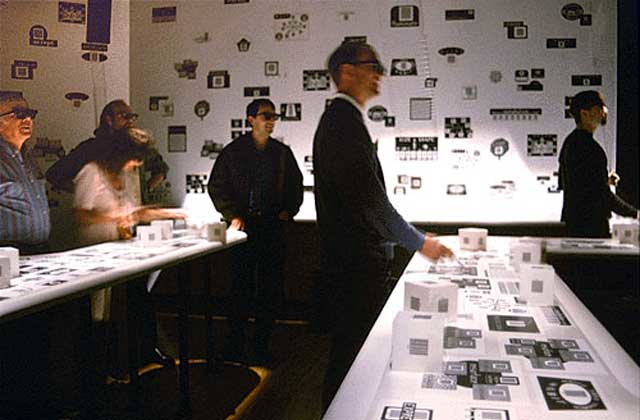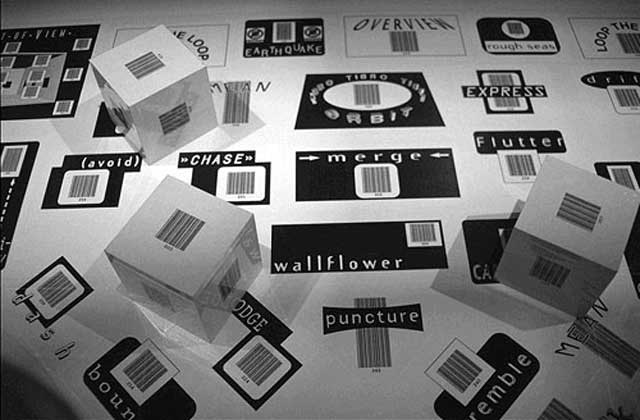Perry Hoberman


Still images from project “Bar Code Hotel“, 1994
Origins Of The Project
Bar Code Hotel was produced under the auspices of the Art and Virtual Environments Project at the Banff Centre for the Arts, in Alberta, Canada.
Upon arrival at the Banff Centre, one is issued an ID card with a photograph and a bar code symbol, which is passed through bar code readers in various locations for various purposes. One afternoon, I swiped my card to pay for a meal, and was promptly informed that I had received some messages. I’d never thought much about bar code before, but it struck me as strange that such entirely different functions could be conjoined.
I started to research bar code technologies, and began to visualize a room in which every available surface was covered with bar code, an entirely black-and-white environment. At this point, I still wasn’t sure what the bar code would actually do, but I assumed I’d think of something. I went ahead and ordered my first bar code reader, and began to decipher the various available symbologies. We even discovered that we could actually (somewhat laboriously) write readable bar codes by hand.
Why Bar Code?
Like any technology, bar code can be enlisted for other, less practical purposes. Misusing something that is normally in the service of control and authority holds the potential to reveal other, less constrictive scenarios. Of course, the ominous overtones of its intended use remain at least faintly audible. Bar code represents an early attempt to bridge the gap between the physical world and the computer. As such, it is the forerunner of present-day attempts to allow computer comprehension of the world as it is (such as optical character recognition and artificial vision), as well as plans to embed digital information invisibly in the environment (ubiquitous computing and augmented reality).
Unlike these contemporary projects (which strive for subtlety, invisibility, a policy of non-intrusion) bar code is blatantly, unavoidably obvious. In fact, this very obviousness became its appeal to me. Bar code makes no attempt to disguise its sole function as an extension of the domain of the digital computer.
As my ideas developed, I started to think of using bar code technology as a kind of caricature of a more conventional virtual reality apparatus. Participants would be “immersed” in a computer-generated world; but this world, instead of being made up of virtual polygonal objects, would be made up of printed black and white symbols. The bar code wands were a kind of cheap substitute for a data glove. Finally, I decided to incorporate 3D projection, necessitating 3D glasses as a surrogate for the inevitable head-mounted display.
The Virtual World
The projected environment consists of a number of computer-generated objects, each one corresponding to a different guest. These objects are brought into being by scanning unique bar codes that are printed on white cubes that are dispersed throughout the room. Once brought into existence, objects exist as semi-autonomous agents that are only partially under the control of their human collaborators. They also respond to other objects, and to their environment. They emit a variety of sounds in the course of their actions and interactions. They have their own behaviors and personalities; they have their own life spans (on the order of a few minutes); they age and (eventually) die.
The objects in Bar Code Hotel are based on a variety of familiar and inanimate things from everyday experience: eyeglasses, hats, suitcases, paper clips, boots, and so on. None of them are based on living creatures; their status as characters (and as surrogates for the user) is tentative, and depends totally upon their movement and interaction. At times they can organize themselves into a sort of visual sentence, an unstable and incoherent rebus.
Objects can interact with each other in a variety of ways, ranging from friendly to devious to downright nasty. They can form and break alliances. Together they make up an anarchic but functioning ecosystem.
Depending on the behavior, personality and interactive “style”, these objects can at various times be thought of in a number of different ways. An object can become an agent, a double, a tool, a costume, a ghost, a slave, a nemesis, a politician, a pawn, a relative, an alien. Perhaps the best analogy is that of an exuberant and misbehaving pet.
Each object develops different capabilities and characteristics, depending on factors like age, size and history. For instance, younger objects tend to respond quickly to bar code scans; as they age, they become more and more sluggish. Older objects begin to malfunction, flickering and short-circuiting. Finally, each object dies, entering briefly into an ghostly afterlife. (This process can be accelerated by scanning suicide.) After each object departs, a new object can be initiated.

Still images of the installation “System Maintenance“, 1998
Note on the artist
Perry Hoberman (born 1954), is an installation artist who has worked extensively with machines and media. His career has included stints with Laurie Anderson and the USC Interactive Media Division. He has taught at the Cooper Union School of Art, the San Francisco Art Institute, and the graduate Computer Art Department in the school of Visual Arts in New York. He is currently an Associate Research Professor in the Interactive Media Division at the University of Southern California School of Cinema-Television, as well as a visiting artist at the California Institute of the Arts. His work is included in the exhibition “Open House: Working In Brooklyn”, currently on view at the Brooklyn Museum.